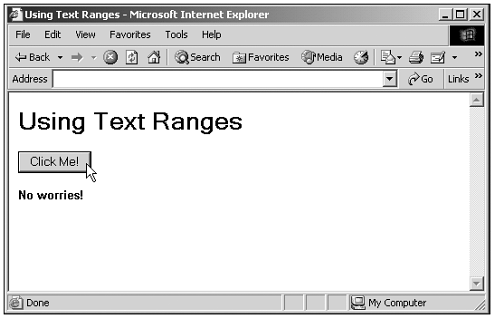Using Text Ranges
| Another way to modify a web page in the Internet Explorer on-the-fly is to use a TextRange object, which we saw in Chapter 11, "Working with HTML Text Elements." In this chapter, I'll take a look at the pasteHTML method, which enables you to change text ranges on-the-fly. Here's an example in which I create a text range with the createTextRange method, select the text of an element ("No problem.") with the moveToElementText method, and replace that text with the pasteHTML method (to "No worries!"): (Listing 16-07.html on the web site)<HTML> <HEAD> <TITLE> Using Text Ranges </TITLE> <SCRIPT LANGUAGE="JavaScript"> <!-- function replaceText() { if(document.body.isTextEdit){ var range = document.body.createTextRange() range.moveToElementText(div1) range.pasteHTML("No worries!") } } // --> </SCRIPT> </HEAD> <BODY> <H1>Using Text Ranges</H1> <INPUT TYPE=BUTTON VALUE="Click Me!" ONCLICK="replaceText()"> <BR> <BR> <DIV ID="div1" STYLE="font-family:Arial, sans-serif; font-weight:bold"> No problem. </DIV> </BODY> </HTML> You can see the results in Figure 16.5. As you can see, text ranges provide you with another way to rewrite web page content on-the-fly. Figure 16.5. Using the pasteHTML method. |
